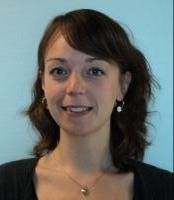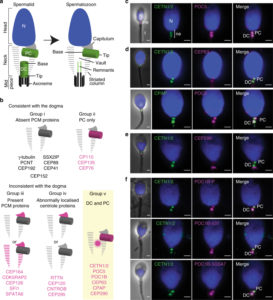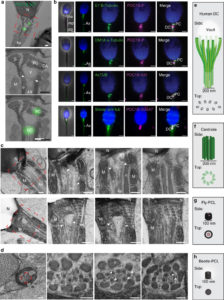
By Dorte Louise Egeberg Palme
A novel atypical sperm centriole is functional during human fertilization
The centriole is a microtubule-based organelle and typically consists of nine sets of short microtubule triplets arranged in a cylindrical structure. The centriole is surrounded by a special matrix, the pericentriolar matrix (PCM). Distinct populations of proteins associate with the centrioles and the PCM, respectively. Two centrioles and the PCM make up a centrosome, present in the cells of most eukaryotes. The centrioles play a major role in cell division where they orchestrate the division of the chromosomes from the spindle poles. During interphase the centriole pair is involved in the formation and anchoring of a primary cilium. In interphase cells the centrioles locate very distinctly with one centriole forming the base of the cilium (the distal centriole – DC) and the other in a perpendicular orientation and closer located towards the nucleus (the proximal centriole – PC). Likewise, a typical centriole is found at the proximal part of the axoneme in the neck region of the human sperm cell. The human oocyte lacks centrioles, and since the human sperm has (at least) one functional centriole, the current believe has been that the centrioles are paternally inherited. However, since centrioles form by duplication of pre-existing centrioles, no one has really been able to explain how the zygote provides two centrioles for each daughter-cell from the single centriole inherited from the father.
With this study Fisherman and colleagues show that the zygotic centrioles indeed are of paternal inheritance, and that the sperm cell does carry two centrioles; the normally-structured PC and an atypically-structured DC along with a remodeled PCM.
The current dogma describes that mature sperm have one centriole (the PC), whereas the DC disintegrates and the proteins that make up the PCM are eliminated during spermiogenesis. Only remnants are left at the base of the axoneme. In the present study, Fishman and colleagues challenged this dogma. Based on findings in insect sperm, they investigated human spermatozoa and bovine zygotes to determine if mammals have a functional atypical second centriole that may be essential for normal fertility and embryo development.
With immunofluorescence microscopy, Fishman and colleagues first identified the location of several unexpected PCM and centriolar proteins. The findings suggest that that the sperm neck structure is a specialized form of PCM. Especially one group of proteins was found to localize to the base of the axoneme – a site corresponding to the former DC. Next, they investigated with advanced microscopic techniques this specific site and observed splayed microtubules at the axoneme base with associated known centriolar proteins. The authors believed that these structures correspond to the DC microtubules and that the DC is not degenerated, but just take on a new appearance – an atypical centrosome structure where the bottom corresponds in size to a typical centriole lumen but then opens much wider than a typical centriole towards the PC. Finally, Fisherman and colleagues found that the sperm cell provides the zygote with two centrioles, the typical centriole (the PC) and the atypical centriole attached to the axoneme base (the remodeled DC), as well as a remodeled, structural PCM. The atypical DC was shown to recruit PCM in vivo, to form a typical centriole, and localize to one of the spindle poles in the zygote.


With this study Fisherman and colleagues show that the zygotic centrioles indeed are of paternal inheritance, and that the sperm cell does carry two centrioles; the normally-structured PC and an atypically-structured DC along with a remodeled PCM. The study is an excellent example of how the refinement of existing technology can challenge our current beliefs.
Future studies might reveal what the purpose of the remodeled DC structure is; is the difference between the PC and atypical DC a cue for early embryonic development, or is it simply a question about achieving the highest possible flexibility in the sperm neck region?
Fishman et al. 2018. “A Novel Atypical Sperm Centriole Is Functional during Human Fertilization.” Nature Communications 9:2210.
